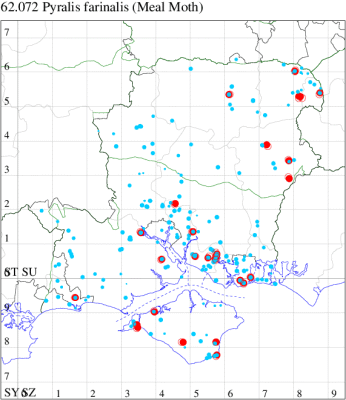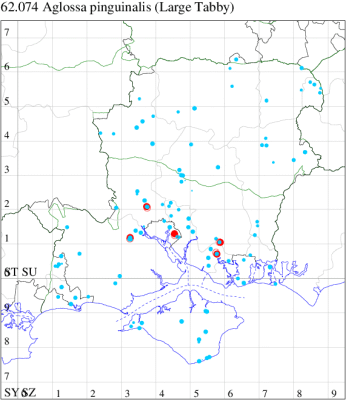2020 Annual Report for: Pyralidae / Pyralinae
For species seen in 2020 that had less than or equal to 100 records, full details are included; for more common species, the earliest, latest and highest count by vice-county are shown. The narrative for each species is taken from the main Hantsmoths website, and it is possible that some information on abundance and occurrence can get out of date, as it is impossible to keep up with all changes; however it should give a good introduction to each species. The tables in each species account summarise the previous status, and that for the current year.
For the maps, all records prior to 2020 are shown by a blue dot (the larger the dot, the more recent), with the current year's records shown in red. As previous records are superimposed on any report for 2020, new sites have greater emphasis (i.e. will show as 'more red').
In the species accounts, an asterisk next to a location indicates a new 10km square record; earliest ever dates are highlighted in orange, and latest ever in red. Initials in the species accounts refer to the recorders listed here. Please get in touch if you identify any omissions or errors, in particular if you have records that have yet to be submitted. Details of how to submit records can be found here.
62.070 [B&F: 1414] Synaphe punctalis (Fabricius, 1775) - Local
Local on shingle beaches, sand-dunes, chalky ground and dry open areas in parts of southern England, predominantly coastal. In Hampshire and on the Isle of Wight common to very common on the coast, occasional inland where it has evidently decreased since the 1970s. Wingspan 22-27 mm. Long-legged, like Dolicharthria punctalis but that has a white discal spot, and second line is much more irregular and less conspicuous [Goater]. Larva feeds on various mosses, often on the ground.
Records prior to 2020
| Vice County | #Records | #Individuals | First Record | Last Record |
|---|---|---|---|---|
| 10 | 487 | 1180 | 1856 | 2019 |
| 11 | 2344 | 8102 | 1800 | 2019 |
| 12 | 69 | 111 | 1951 | 2019 |
2020 records
| Vice County | #Records | #Individuals | Max Quantity |
|---|---|---|---|
| 10 | 46 | 210 | 40 |
| 11 | 82 | 130 | 9 |
| 12 | 22 | 34 | 6 |

Records by year
Records by week (adult)
Records by week (larval)
Record Summary
VC10: Earliest: Bonchurch, 02 Jun, 1 (JHa) Latest: Haseley Manor, 11 Aug, 2 (IOu) Max count: Shippards Chine, Compton Bay, 16 Jul, 40 (IOu)
VC11: Earliest: Totton, 09 Jun, 1 (LH) Latest: Botley, 28 Sep, 1 (SLB) Max count: Burton, nr Christchurch, 10 Jul, 9 (JSw)
VC12: Earliest: Chilbolton, 16 Jun, 1 (GCE) Latest: Yateley, 31 Jul, 1 (JHH) Max count: Crawley, 30 Jun, 6 (GCE)
62.072 [B&F: 1417] Meal Moth Pyralis farinalis (Linnaeus, 1758) - Common
Common in farm buildings, barns, warehouses and granaries, also sometimes in houses, across much of Britain, occasionally recorded in the wider countryside. Distributed widely and evenly over Hampshire and on the Isle of Wight, with no particular pattern. Wingspan 22-30 mm. Nocturnal, but often easy to find on walls during the day. Main confusion species are P. lienigialis, which is much darker and lacks contrastingly pale median area, and Painted Meal Moth P. pictalis, which has straighter fasciae on forewing. Larva feeds on dried goods, cereals, grain and dry vegetable matter.
Records prior to 2020
| Vice County | #Records | #Individuals | First Record | Last Record |
|---|---|---|---|---|
| 10 | 45 | 27 | 1856 | 2018 |
| 11 | 1101 | 964 | 1951 | 2019 |
| 12 | 174 | 164 | 1951 | 2019 |
2020 records
| Vice County | #Records | #Individuals | Max Quantity |
|---|---|---|---|
| 10 | 7 | 7 | 1 |
| 11 | 72 | 80 | 2 |
| 12 | 12 | 13 | 2 |

Records by year
Records by week (adult)
Records by week (larval)
Record Summary
VC10: Earliest: Bonchurch, 22 Jun, 1 (JHa) Latest: Afton Marsh, 28 Sep, 1 (IOu) Max count: Freshwater Cliffs, 16 Jul, 1 (SDa)
VC11: Earliest: Southsea, 26 May, 1 (JRL) Latest: Fareham, 01 Oct, 1 (KJW) Max count: Totton, 06 Jul, 2 (LH)
VC12: Earliest: Yateley, 27 May, 1 (JHH) Latest: Farnborough, 28 Sep, 1 (KBW) Max count: Farnborough, 25 Jun, 2 (KBW)
62.074 [B&F: 1421] Large Tabby Aglossa pinguinalis (Linnaeus, 1758) - Local
Local around farm buildings, barns, warehouses and granaries throughout the British Isles. In Hampshire and on the Isle of Wight probably overlooked due to its association with farm buildings, with less than ten records in most years, but over 20 records in 2005. Wingspan 30-40 mm. Very variable in size, but not really similar to any other British moth. Larva feeds on detritus and animal waste.
Records prior to 2020
| Vice County | #Records | #Individuals | First Record | Last Record |
|---|---|---|---|---|
| 10 | 23 | 13 | 1856 | 2019 |
| 11 | 131 | 102 | 1947 | 2019 |
| 12 | 73 | 64 | 1951 | 2019 |
2020 records
| Vice County | #Records | #Individuals | Max Quantity |
|---|---|---|---|
| 11 | 5 | 4 | 1 |

Records by year
Records by week (adult)
Records by week (larval)
Record Details
VC11: Woodlands, New Forest, present, 18 Jul (RBW); Romsey, one, field observation, 24 Jun (MB); Bitterne, one, to actinic, 31 Jul (PAB); Fareham, one, 17 Jun (KJW); Wickham Common, one, 16 Jul (KC)
62.075 [B&F: 1413] Gold Triangle Hypsopygia costalis (Fabricius, 1775) - Common
Common in gardens, woodland and farmland throughout southern England. Widespread and common in Hampshire and on the Isle of Wight. Wingspan 18-22 mm. One of the brightest-coloured and most easily recognisable micros, it has two distinct resting postures. Larva feeds on dry vegetable matter, hay and dead grasses.
Records prior to 2020
| Vice County | #Records | #Individuals | First Record | Last Record |
|---|---|---|---|---|
| 10 | 180 | 177 | 1856 | 2019 |
| 11 | 2742 | 3380 | 1951 | 2019 |
| 12 | 662 | 799 | 1951 | 2019 |
2020 records
| Vice County | #Records | #Individuals | Max Quantity |
|---|---|---|---|
| 10 | 22 | 24 | 2 |
| 11 | 72 | 86 | 4 |
| 12 | 16 | 17 | 2 |

Records by year
Records by week (adult)
Records by week (larval)
Record Summary
VC10: Earliest: Bonchurch, 22 Jun, 1 (JHa) Latest: Afton Marsh, 28 Sep, 1 (IOu) Max count: Walter's Copse, Newtown, 22 Sep, 2 (PBa)
VC11: Earliest: Romsey, 26 May, 1 (SLay) Latest: Wickham Common, 20 Oct, 1 (KC) Max count: Ashurst, NF, 15 Sep, 4 (SAB)
VC12: Earliest: Basingstoke, 09 Jun, 1 (DLev) Latest: Pamber Forest, 20 Oct, 1 (GJD) Max count: Cholderton, 24 Jul, 3 (TJN, HE)
62.076 [B&F: 1415] Hypsopygia glaucinalis (Linnaeus, 1758) - Common
Common around sheds and farm buildings, in gardens, hay-stacks, thatched roofs and bird nests throughout southern England. Widespread and common in Hampshire and on the Isle of Wight. Wingspan 23-30 mm. Larva feeds on decaying vegetable matter such as hay, and on detritus in bird nests.
Records prior to 2020
| Vice County | #Records | #Individuals | First Record | Last Record |
|---|---|---|---|---|
| 10 | 62 | 53 | 1900 | 2019 |
| 11 | 1785 | 1730 | 1951 | 2019 |
| 12 | 494 | 529 | 1951 | 2019 |
2020 records
| Vice County | #Records | #Individuals | Max Quantity |
|---|---|---|---|
| 10 | 1 | 1 | 1 |
| 11 | 54 | 54 | 2 |
| 12 | 8 | 8 | 1 |

Records by year
Records by week (adult)
Records by week (larval)
Record Details
VC10: Shanklin, one, 24 Jun (IOu);
VC11: Hale Purlieu, one, to actinic, 13 Aug (MCu); Woodlands, New Forest, present, 09 Aug (RBW); Ashurst, NF, one, 08 Aug; one, 12 Aug; one, 15 Sep (SAB); Totton, one, 30 May; one, 10 Aug (LH); Romsey, one, 25 Jun (SC); one, 23 Jun; one, 20 Sep (MB); one, 17 Aug (NRJ); Kings Somborne, one, to actinic, 28 Sep; Ashley, one, to actinic, 22 Sep (GCE); Dibden Purlieu, one, to actinic, 09 Aug; one, to actinic, 11 Aug; one, 18 Sep; one, to actinic, 23 Jul; one, to actinic, 24 Jul (RAC); Southampton, one, 11 Aug (MEdg); Allbrook, one, 30 Jul; one, 08 Aug; one, 09 Aug; one, to actinic, 14 Aug; one, 18 Aug (SI); Catisfield, one, 24 Jun (ALR); Fareham, one, 14 Sep (ADT); one, 11 Aug; one, 16 Sep (IMcP); one, to actinic, 22 Jul; one, to actinic, 08 Aug; one, to actinic, 09 Aug; two, to actinic, 20 Oct; one, to actinic, 22 Oct (MLO); one, 22 Jul; one, 26 Jul; one, 05 Aug; one, 07 Aug; one, 10 Aug; one, 29 Sep; one, 20 Oct (KJW); Botley, one, to actinic, 18 Jun; one, to actinic, 03 Aug (SLB); Wickham, one, 24 Jul (JRDS); Portsmouth, one, 21 Jun; one, 13 Jul; one, 15 Jul; one, 16 Jul; one, 24 Jul (IRT); Lovedean, one, 31 Jul (ARJ); West Meon, one, 31 Jul (F.M.G.); Burton, nr Christchurch, one, 17 Jul (JSw); Milford on Sea, one, 25 Jun; one, 07 Aug (MMcM); Pennington, one, 13 Aug (RFC);
VC12: Cholderton, one, 17 Jul; present, 31 Jul (TJN, HE); one, field observation, 11 Aug (TJN, LF); Crawley, one, 25 Jun (TNo); Barton Stacey, one, to actinic, 25 Jun; one, to actinic, 11 Aug (GCE); Ecchinswell, one, to actinic, 15 Aug (MTa, CSu); Basingstoke, one, 24 Jun (MJW); Selborne, one, 22 Oct (CJP); Whitehill, one, to actinic, 13 Jul; one, 28 Sep (ASto); Castle Bottom NNR, one, 25 Jun (JHH, AMD); Yateley, one, 13 Aug; one, 23 Jun; one, 31 Jul (JHH)
62.077 [B&F: 1424] Endotricha flammealis ([Denis & Schiffermüller], 1775) - Common
Common in woodland, heathland, gardens and waste ground throughout southern Britain. Widespread and common in Hampshire and on the Isle of Wight. Wingspan 18-22 mm. The combination of relatively small size and distinctive resting posture, with head raised high, make this species readily recognisable, although it can be variably coloured. Larva feeds on Greater Bird's-foot Trefoil, and various species of deciduous tree, including Oak and Sallow.
Records prior to 2020
| Vice County | #Records | #Individuals | First Record | Last Record |
|---|---|---|---|---|
| 10 | 582 | 2134 | 1981 | 2019 |
| 11 | 7705 | 20414 | 1951 | 2019 |
| 12 | 1776 | 5441 | 1951 | 2019 |
2020 records
| Vice County | #Records | #Individuals | Max Quantity |
|---|---|---|---|
| 10 | 48 | 249 | 75 |
| 11 | 441 | 2963 | 540 |
| 12 | 152 | 635 | 39 |

Records by year
Records by week (adult)
Records by week (larval)
Record Summary
VC10: Earliest: Bonchurch, 11 Jun, 1 (JHa) Latest: Shanklin, 17 Aug, 1 (IOu) Max count: Parkhurst Forest, 29 Jun, 75 (IOu)
VC11: Earliest: Totton, 29 May, 1 (LH) Latest: Burton, nr Christchurch, 23 Oct, 1 (JSw) Max count: Hursley, 09 Jul, 540 (GCE)
VC12: Earliest: Hammer Vale, Woolmer, 08 Jun, 1 (ASw) Latest: Whitehill, 22 Oct, 1 (ASto) Max count: Pamber Forest, 08 Jul, 39 (GJD)